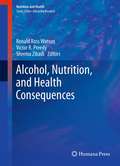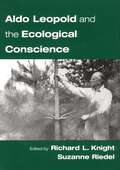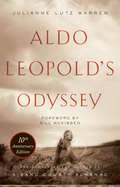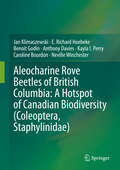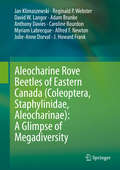- Table View
- List View
Alcohol, Nutrition, and Health Consequences (Nutrition and Health)
by Ronald Ross Watson, Victor R. Preedy and Sherma ZibadiChronic alcohol use is associated with heart, liver, brain, and other organ pathology. Alcohol is a drug of abuse and a caloric food and it causes poor intake and absorption of nutrients, thus playing a major role in many aspects of clinical consequences. Alcohol use lowers consumption of fruit and vegetables, lowers tissue nutrients, and, in some cases, requires nutritional therapy by clinicians. Alcohol, Nutrition, and Health Consequences will help the clinician define the causes and types of nutritional changes due to alcohol use and also explain how nutrition can be used to ameliorate its consequences. Chapters present the application of current nutritional knowledge by physicians and dietitians. Specific areas involving alcohol-related damage due to nutritional changes are reviewed, including heart disease, obesity, digestive tract cancers, lactation, brain function, and liver disease. In addition, alcohol’s effects on absorption of minerals and nutrients, a key role in causing damage are treated. The importance of diet in modifying alcohol and its metabolite damage is also explained. Alcohol, Nutrition, and Health Consequences is essential reading for alcohol therapists and researchers as well as primary care physicians and dietitians and is an easy reference to help the clinician, student, and dietitian comprehend the complex changes caused by direct and indirect effects of ethanol at the cellular level via its nutritional modification.
Alcohol percentage of beer (tactile)
by RnibA graph showing how the percentage of alcohol changes over time. The y axis shows percentage of alcohol. The x axis shows time (days)
Alcohol percentage of beer (tactile)
by RnibA graph showing how the percentage of alcohol changes over time. The y axis shows percentage of alcohol. The x axis shows time (days)
Alcohol Related Diseases in Gastroenterology
by BurkhardKommerell Helmut KarlSeitzAlcohol abuse ranks among the most common and also the most severe environmental hazards to human health. Its significance is heightened by the possibility of prevention by elimination of the habit, however, rarely exerted. The incidence of deleterious effects on human health has relentlessly risen in the past years for a variety of factors. They include migration of populations and, particularly, increased urbanization. Thus, in some parts of the world, population groups previously spared have become involved, which is also re flected in the increasing number of breweries and distilleries in the developing countries. Social, religious, and gender-related barriers to alcohol consumption are loosening, and the financial improvement of some segments of populations now enable them to buy alcoholic beverages. Thus the greatest percentage rise in the United States has recently been in black women. Adolescents and young people drink more alcoholic beverages than ever, and growing alcohol abuse by pregnant women has let to an increase of the incidence of the fetal alcohol syndrome. While the social and behavioral, including psychiatric, consequences of alcoholism are staggering, the gastrointestinal and, particularly, hepatic manifestations are the most widespread somatic effects, and chronic hepatic disease in alcoholics appears to cause the greatest cost to society. Indeed, mortality from liver cirrhosis is considered a reliable index of alcohol consumption in a country.
Alcohol thermometer (Large Print)
by RnibThis is an image of an alcohol thermometer fixed to a backing plate. This type of thermometer is used for measuring air temperature.There is a locator dot shown, which will be at the top left of the page when the image is the correct way up.The thermometer is in the middle of the page mounted vertically on the left side of a rectangular backing plate. It consists of a glass tube with a round bulb at the bottom, partially filled with red-dyed liquid ethanol. The ethanol will expand and rise up the tube as the temperature of the surrounding air increases. The level of the ethanol here has risen to the 10 degree mark.There is a scale to the left of the thermometer is marked from minus 40 degrees Celsius at the bottom to 50 degrees at the top. The minus degree markings below zero do not have a minus sign. Thermometers of this type can be used to measure temperatures from minus 70 to 78 degrees Celsius and are commonly used for meteorological purposes.
Alcohol thermometer (UEB Contracted)
by RnibThis is an image of an alcohol thermometer fixed to a backing plate. This type of thermometer is used for measuring air temperature.There is a locator dot shown, which will be at the top left of the page when the image is the correct way up.The thermometer is in the middle of the page mounted vertically on the left side of a rectangular backing plate. It consists of a glass tube with a round bulb at the bottom, partially filled with red-dyed liquid ethanol. The ethanol will expand and rise up the tube as the temperature of the surrounding air increases. The level of the ethanol here has risen to the 10 degree mark.There is a scale to the left of the thermometer is marked from minus 40 degrees Celsius at the bottom to 50 degrees at the top. The minus degree markings below zero do not have a minus sign. Thermometers of this type can be used to measure temperatures from minus 70 to 78 degrees Celsius and are commonly used for meteorological purposes.
Alcohol thermometer (UEB Uncontracted)
by RnibThis is an image of an alcohol thermometer fixed to a backing plate. This type of thermometer is used for measuring air temperature.There is a locator dot shown, which will be at the top left of the page when the image is the correct way up.The thermometer is in the middle of the page mounted vertically on the left side of a rectangular backing plate. It consists of a glass tube with a round bulb at the bottom, partially filled with red-dyed liquid ethanol. The ethanol will expand and rise up the tube as the temperature of the surrounding air increases. The level of the ethanol here has risen to the 10 degree mark.There is a scale to the left of the thermometer is marked from minus 40 degrees Celsius at the bottom to 50 degrees at the top. The minus degree markings below zero do not have a minus sign. Thermometers of this type can be used to measure temperatures from minus 70 to 78 degrees Celsius and are commonly used for meteorological purposes.
Alcoholism: New Directions in Behavioral Research and Treatment (Nato Conference Series #7)
by Peter E. Nathan G. Alan MarlattThis book contains the fifteen invited papers delivered at the NATO International Conference on Experimental and Behavioral Appro aches to Alcoholism, held August 28 through September 1, 1977, at the Solstrand Fjord Hotel, Os, Norway. The editors of the book were Co-Directors of that conference. As well, 65 other scientists from 12 countries in the free world presented scientific papers on ex perimental and behavioral topics of relevance to alcoholism at the meeting. A most receptive audience of almost 200 persons also par ticipated actively in the discussions which followed every invited and contributed paper. The beauty of Norway, the hospitality of the proprietors of the Sol strand Fjord Hotel, the aura of Grieg and Troldhaugen, the en thusiasm of the speakers and participants - all combined to make the conference most memorable for those who attended it. Many persons and institutions deserve special thanks for their part in the success of the conference. Among these persons are Dr.
Alcoholism: A Molecular Perspective (Nato Science Series A: #206)
by T. Norman PalmerThis book contains selected proceedings from the NATO Advanced Study Institute (AS I) "The Molecular Pathology of Alcoholism" held at the Hotel Il Ciocco in Tuscany during 26th August - 6th September 1990. Alcoholism remains one of the most challenging problems in medical care, with far-reaching medical, social and economic consequences. For example in the U. S. , estimates indicate that 18 million people have a serious drinking problem and that the total cost to the economy of alcohol abuse is $117 billion. Treatment of alcohol dependence and other alcohol-related disorders accounts for almost 15% of the total health bill of the United States. Despite the scale of the medical problem, biomedical research on alcoholism remains something of a 'Cinderella science'. Research funding from government and other bodies is relatively poor and the number of medical scientists working in the field remains small. The Organizing Committee for this NATO ASI, comprising Charles Lieber (New York), Timothy Peters (London), Mario Dianzani (Torino), Emanuele Albano (Torino) and Norman Palmer (perth, Director), were therefore particularly grateful to the NATO Scientific Affairs Division for their active support of this AS I, the first dealing with a topic related to alcohol abuse. We moreover hope that this support will continue. The theme of the ASI was an in depth discussion of the molecular events initiated by alcohol abuse that culminate in onset of alcohol-related disease.
Alcoholism and Drug Dependence: A Multidisciplinary Approach
by J. S. Madden, Robin Walker and W. H. KenyonIt is for me, as President of the Merseyside Lancashire & Cheshire Council on Alcoholism, a signal privilege to write a brief foreword to these Proceedings of the Third International Conference on Alcoholism and Drug Dependence. During the week experts, from the world over, in all those disciplines which have a contribution to make to the solution of the problems of alcoholism and drug dependence, surveyed recent advances in our knowledge of the aetiology, epidemiology, early recognition, management, and the social and industrial implications of these twin scourges of the contemporary scene. The discussions were most helpful and enlightening even when a wide spectrum of conflicting views and experiences were revealed. The justification for adding yet another volume to the growing literature in this field is two-fold; first, that those taking part in the conference can study at leisure and in depth the transactions of the conference; and secondly, that those who were unable to attend might benefit from the most recent views of international experts in the diverse facets of one of the major current problems in world health. LORD COHEN OF BIRKENBEAD CH, PRSH, MD, DSc, ScD, LLD, DCL, FRCP, DL, JPo CONTENTS Introduction . . • . . . . . . . . . . . .
Alcoholism in America: From Reconstruction to Prohibition
by Sarah W. TracyDespite the lack of medical consensus regarding alcoholism as a disease, many people readily accept the concept of addiction as a clinical as well as a social disorder. An alcoholic is a victim of social circumstance and genetic destiny. Although one might imagine that this dual approach is a reflection of today's enlightened and sympathetic society, historian Sarah Tracy discovers that efforts to medicalize alcoholism are anything but new.Alcoholism in America tells the story of physicians, politicians, court officials, and families struggling to address the danger of excessive alcohol consumption at the turn of the century. Beginning with the formation of the American Association for the Cure of Inebriates in 1870 and concluding with the enactment of Prohibition in 1920, this study examines the effect of the disease concept on individual drinkers and their families and friends, as well as the ongoing battle between policymakers and the professional medical community for jurisdiction over alcohol problems. Tracy captures the complexity of the political, professional, and social negotiations that have characterized the alcoholism field both yesterday and today.Tracy weaves American medical history, social history, and the sociology of knowledge into a narrative that probes the connections among reform movements, social welfare policy, the specialization of medicine, and the social construction of disease. Her insights will engage all those interested in America's historic and current battles with addiction.
Alcohols - Methanol, Ethanol, Propanol and Butanol (tactile)
by RnibThis diagram shows the chemical structure and symbol for Methanol, ethanol, propanol, and butanol.
Alcyonarien-Sklerite aus dem Torton des Burgenlandes, Österreich (Sitzungsberichte der Österreichischen Akademie der Wissenschaften)
by Edith TollmannAldehyde Dehydrogenases: From Alcohol Metabolism to Human Health and Precision Medicine (Advances in Experimental Medicine and Biology #1193)
by Jun Ren Yingmei Zhang Junbo GeThis volume covers the science of ALDH enzymes in relation to chronic disease processes and the future therapeutic potentials of targeting ALDH in these processes. It thoroughly reviews the roles of ALDH family in alcohol metabolism, as well as recent findings of their emerging roles in a variety of human pathologies such as cardiovascular diseases, diabetes, obesity, stroke, cancer, liver diseases and kidney diseases. Delicate contribution of ALDH enzymes in the therapeutics against chronic diseases is also discussed. It demonstrates the unique value of targeting genetic polymorphism in ALDH enzymes in personalized medicine. The book will appeal to scientists, physicians, graduate and professional students in the fields of ALDH enzymes, alcohol metabolism, cardiometabolic and other chronic diseases. Pharmaceutical and other companies developing new tools for cardiometabolic and chronic diseases treatment will also find this a valuable resource.
Aldo Leopold and the Ecological Conscience
by Richard L. Knight Susanne RiedelIn Aldo Leopold and an Ecological Conscience ecologists, wildlife biologists, and other professional conservationists explore the ecological legacy of Aldo Leopold and his A Sand County Almanac and his contributions to the environmental movement, the philosophy of science, and natural resource management. Twelve personal essays describe the enormous impact he has had on each author, from influencing the daily operations of the U.S. Fish and Wildlife Service and the creation of a land-use ethics guide for Forest Service personnel, to much needed inspiration for continuing on in today's large, complex and often problematic world of science. Here is Aldo Leopold as a mentor, friend, and companion and an affirmation of his hope that science will continue to be practiced in the cause of conservation.
Aldo Leopold's Odyssey, Tenth Anniversary Edition: Rediscovering the Author of A Sand County Almanac
by Julianne Lutz WarrenMore than a biography, this articulate volume is a guide to the intellectual growth of conservationist Aldo Leopold (1887-1948) and an inspirational resource for anyone pondering the relationships between people and the land.
Aldol Reactions
by Rainer MahrwaldAldol Reactions provides a comprehensive up-to-date overview of aldol reactions including application of different metal enolates; catalytic aldol additions catalyzed by different Lewis acids and Lewis bases; enantioselective direct aldol additions; antibodies and enzyme catalyzed aldol additions and the recent aggressive development of organocatalyzed aldol additions. The power of each method is demonstrated by several applications in total synthesis of natural products. The pros and cons of these methodologies with regard to stereoselectivity, regioselectivity and application in total synthesis of natural products are discussed. Great importance is set to the diverse possibilities of the manual of aldol reaction to install required configurations in complicated natural product synthesis.
Aldous Huxley and the Mysticism of Science
by J. DeeryCan religious belief survive in a scientific era? Aldous Huxley thought so. His early recognition of the profound significance of twentieth-century science and the need for moral and spiritual direction resulted in his espousal of mysticism. An examination of his fiction and nonfiction reveals Huxley's significance for cross-disciplinary debates between religion, science and literature and provides examples of the transmission or refraction of knowledge from one discourse to another.
Aleksandr Porfir’evich Borodin: A Chemist’s Biography
by N.A. Figurovskii Yu.I. Solov'evA full century has passed since the sudden and tragically premature demise of Aleksandr Porfir'evich Borodin in 1887 at the age of 53, when he was following with phenomenal success the disparate careers of musician, composer, organic chemist, and pioneer in women's medical education. As a unique figure among the remarkable group of geniuses who suddenly appeared in Russia in the middle of the last century and explosively propelled that country into the mainstream of world culture in the arts, humanities, and sciences, it might have been expected that Borodin was the object of much research. There is no doubt that the Russian contribution to the amazing development of structural chemistry in the last century has tended to be underplayed, while that in the rest of Europe has received much more attention. One wonders, in particular, whether Borodin's name might not have appeared in the chemical pantheon, as have those of Mendeleev, Markovnikov, Menshutkin, and many other Russians, if the aldol condensation, which he was the first to discover and investigate, had been named the Borodin condensation. Straightening out the record is important; Figurovskii and Solov'ev's biography does much in this respect. Just as meritorious have been the scholarly and exhaustive efforts of Professors Charlene Steinberg and George B. Kauffman, who have made the Russian text accessible to the Western world in their accurate and engrossing translation.
Aleocharine Rove Beetles of British Columbia: A Hotspot of Canadian Biodiversity (Coleoptera, Staphylinidae)
by Jan Klimaszewski E. Richard Hoebeke Benoit Godin Anthony Davies Kayla I. Perry Caroline Bourdon Neville WinchesterAleocharine beetles are among the most poorly known and difficult-to-identify groups of Coleoptera worldwide. This book presents the first comprehensive synopsis of aleocharine rove beetle species (Coleoptera, Staphylinidae) from British Columbia, Canada. It is important to generate a structured inventory of species in hotspots of biodiversity like British Columbia, to provide baseline biodiversity data for monitoring species responses related to climate change. It is the first book to treat and illustrate every recorded and new species. For every species, color illustrations are provided, including color habitus and genital diagnostic structures of both sexes. Two hundred and twenty-seven valid species, including 14 new species, 16 new generic records, and 36 (excluding new species) new provincial and 6 state records, in 79 genera and 14 tribes.Tribes and subtribes are arranged in phylogenetic order as it is currently recognized, and genera and subgenera are listed alphabetically within each tribe or subtribe. Species are listed alphabetically or in species groups to better reflect their relationships. Species distribution is listed by provinces and territories in Canada and states in the United States, and the geographic origin of each species is categorized as native, Holarctic, adventive or undetermined (either adventive or Holarctic). Every species is presented with a morphological diagnosis including external and genital characters of both sexes. Collection and habitat data are presented for each species, including collecting period, and collecting methods. A list of all Canadian species with their currently known distribution in North America is presented at the end of the book.
Aleocharine Rove Beetles of Eastern Canada (Coleoptera, Staphylinidae, Aleocharinae): A Glimpse of Megadiversity
by Jan Klimaszewski Reginald P. Webster David W. Langor Adam Brunke Anthony Davies Caroline Bourdon Myriam Labrecque Alfred F. Newton Julie-Anne Dorval J. Howard FrankA first comprehensive synopsis of all aleocharine rove beetle species (Coleoptera, Staphylinidae) recorded from eastern Canada, from Ontario to the Maritime Provinces inclusively, is presented. Four hundred and seven species in 96 genera, and 16 tribes are presented and discussed.Tribes and subtribes are arranged in presumably phylogenetic order as it is currently recognized. Genera and subgenera are listed alphabetically. Species are listed alphabetically or in species groups to better reflect their relationships. Species distribution is listed by abbreviated provinces and territories in Canada and abbreviated states in the United States. Geographic status is given to every species as Native, Holarctic or adventive with some species listed with undetermined status - adventive or Holarctic. Every treated species is presented with a diagnosis, including short description of body and description of the median lobe of aedeagus, spermatheca, and tergite and sternite VIII of both sexes. For each species a plate with colour habitus image and black and white images of genital structures is provided to aid with positive identification. Collection and habitat data (often new) are presented for each species, including data on macrohabitat, microhabitat, collecting period, and collecting methods.
ALERT • Adverse Late Effects of Cancer Treatment: Volume 2: Normal Tissue Specific Sites and Systems (Medical Radiology)
by Philip Rubin Louis S. Constine Lawrence B. MarksThe literature on the late effects of cancer treatment is widely scattered in different journals since all major organ systems are affected and management is based on a variety of medical and surgical treatments. The aim of "ALERT – Adverse Late Effects of Cancer Treatment" is to offer a coherent multidisciplinary approach to the care of cancer survivors. Volume 2 of this two-volume work comprehensively documents potential late effects in all the normal tissue anatomic sites in the human body. The detection, diagnosis, management and prevention of effects are all considered in detail, and prognostic outcomes are discussed. Radiation risk factors and interactions with chemotherapy effects are clearly presented. The text is accompanied by numerous supportive illustrations and tables. It is anticipated that this textbook will become the gold standard in providing information on the late effects of cancer treatment and that, in its digitized form, it will be referenced in cancer survivorship guidelines.
ALERT - Adverse Late Effects of Cancer Treatment: Volume 1: General Concepts and Specific Precepts (Medical Radiology)
by Philip Rubin Louis S. Constine Lawrence B. MarksThe literature on the late effects of cancer treatment is widely scattered in different journals since all major organ systems are affected and management is based on a variety of medical and surgical treatments. The aim of "ALERT – Adverse Late Effects of Cancer Treatment" is to offer a coherent multidisciplinary approach to the care of cancer survivors. The Volume focuses on the general concepts and principles relevant to late effects and on the dynamic interplay of molecular, cytologic and histopathologic events that lead to altered physiologic and metabolic functions and their clinical manifestations. Chapters are also included on legal issues, economic aspects, nursing, psychological issues and quality of life. It is anticipated that this textbook will become the gold standard in providing information on the late effects of cancer treatment and that, in its digitized form, it will be referenced in cancer survivorship guidelines.
Alexander Graham Bell: Making Connections (Oxford Portraits in Science)
by Naomi PasachoffAlexander Graham Bell forever changed the world. The telephone and his many other landmark inventions rank among the most transforming and enduring of the modern era. But it was his work with the deaf, teaching as well as inventing tools to ease communication, that he considered his life's work. The son of a speech therapist father and hearing impaired mother, his stellar achievements in sound reproduction and aviation give proof that he fit his own definition of an inventor. He said, "An inventor a man who looks upon the world and is not contented with things as they are. He wants to improve whatever he sees, he wants to benefit the world." This is a compelling biography of a true scientific visionary. Oxford Portraits in Science is an on-going series of scientific biographies for young adults. Written by top scholars and writers, each biography examines the personality of its subject as well as the thought process leading to his or her discoveries. These illustrated biographies combine accessible technical information with compelling personal stories to portray the scientists whose work has shaped our understanding of the natural world.
Alexander L. George: With a Foreword by Dan Caldwell (Pioneers in Arts, Humanities, Science, Engineering, Practice #15)
by Dan CaldwellAlexander L. George was one of the most productive and respected political scientistsof the late twentieth century. He and his wife, Juliette George, wrote one of the firstpsychobiographies, and Professor George went on to write seminal articles and booksfocusing on political psychology, the operational code, foreign policy decisionmaking,case study methodology, deterrence, coercive diplomacy, policy legitimacy, and bridgingthe gap between the academic and policymaking communities. This book is the firstand only one to contain examples of the works across these fields written by AlexanderGeorge and several of his collaborators.• This is a collection of Alexander L. George's works from the major fields to whichhe contributed.• There are biographical essays by his wife and co-author (Juliette L. George), daughter(Mary George Douglass), former student (Dan Caldwell), and professional colleague(Janice Gross Stein).• There are 25 photographs of Alexander L. George and his family which have notpreviously been published.
